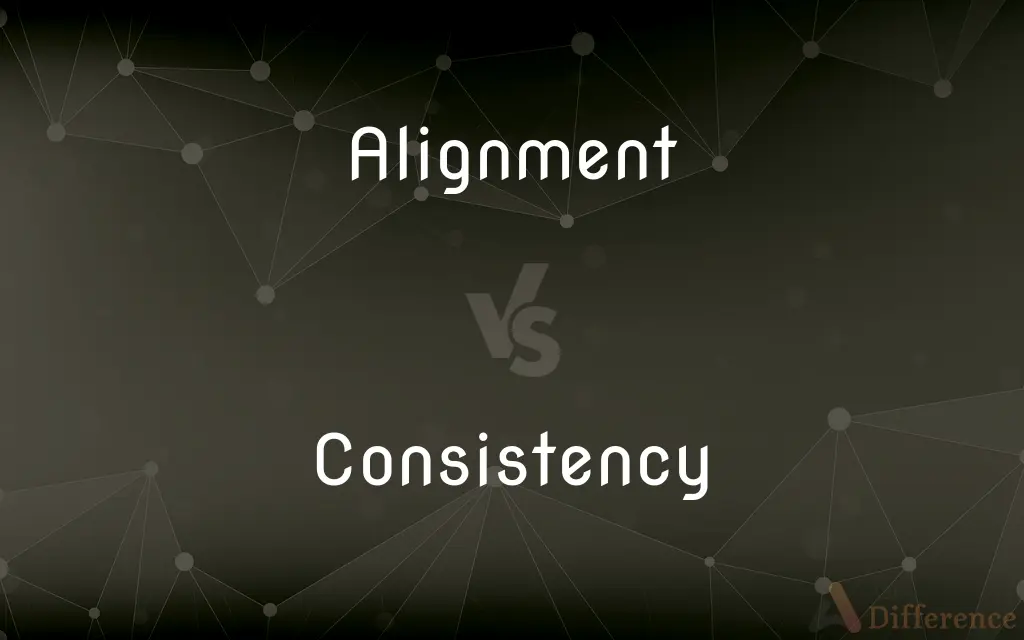Alignment vs. Consistency — What's the Difference?
By Maham Liaqat & Fiza Rafique — Updated on March 28, 2024
Alignment refers to the arrangement of elements to ensure they form a straight line or correct relative positions, while consistency involves uniformity and coherence in application or behavior across different scenarios.

Difference Between Alignment and Consistency
Table of Contents
ADVERTISEMENT
Key Differences
Alignment focuses on the positioning and orderly arrangement of components within a system, ensuring they are correctly adjusted relative to each other or to a set standard. This concept is crucial in fields like design, where visual elements need to be arranged harmoniously, and in organizations, where strategies and goals must align with core values. On the other hand, consistency refers to the repetition of patterns, behaviors, or standards over time, ensuring uniformity and predictability in processes, products, or actions. This is essential for building trust in brands, maintaining quality in production, and creating reliable user experiences.
While alignment emphasizes the proper placement and coordination among elements at a given moment, consistency extends this harmony over time, across different contexts or applications. For instance, a company might align its departments' goals for a specific project, but ensuring those goals are consistently met over various projects requires systematic adherence to core principles and strategies.
In design, alignment ensures elements on a page or in a space are organized in a visually pleasing manner, enhancing readability and aesthetic appeal. Conversely, consistency in design refers to maintaining a coherent look and feel across a brand's various materials, reinforcing brand identity and improving user experience.
Alignment and consistency are interrelated yet distinct: alignment is often a prerequisite for consistency, especially in dynamic environments where adjustments are frequently made. Achieving consistency in alignment, whether in design, strategy, or behavior, signals a mature and well-managed system capable of delivering predictable and high-quality outcomes.
Both concepts play critical roles in various domains, from engineering, where mechanical parts must be precisely aligned and operate consistently, to user interface design, where elements need to be aligned for usability while maintaining a consistent style across the platform. These principles together ensure systems are not only aesthetically pleasing and efficient but also reliable and trustworthy.
ADVERTISEMENT
Comparison Chart
Efinition
Arrangement of elements in correct positions or orientation.
Uniformity and coherence in behavior or appearance over time.
Focus
Positioning and adjustment of components relative to each other.
Repetition of patterns or standards across different scenarios.
Importance
Ensures harmony and efficiency in the immediate context.
Builds trust and reliability through predictable outcomes.
Application Examples
Visual design alignment, organizational goal alignment.
Branding consistency, quality control in manufacturing.
Relation
A step towards achieving a harmonious system at a specific time.
Extends principles or standards uniformly over time and contexts.
Compare with Definitions
Alignment
It ensures components fit correctly.
The alignment of gears in a machine for smooth operation.
Consistency
Consistency means uniformity in actions or appearance.
Maintaining a consistent brand voice across all platforms.
Alignment
Alignment involves positioning according to a standard.
Aligning team goals with the company.s mission.
Consistency
Behavioral consistency is key in building trust.
A leader consistently supporting team members.
Alignment
Strategic alignment focuses on coordinating efforts.
Aligning marketing strategies with sales objectives.
Consistency
It involves repeating patterns or standards.
Consistency in product quality to meet customer expectations.
Alignment
Alignment is the orderly arrangement of elements.
Aligning text and images for visual harmony in a document.
Consistency
Operational consistency ensures reliable outcomes.
Consistent procedures in manufacturing for product uniformity.
Alignment
In design. it enhances aesthetics and functionality.
Aligning UI elements for better user navigation.
Consistency
In UI design. consistency improves usability.
Using consistent icons and colors for better user experience.
Alignment
Arrangement or position in a straight line or in parallel lines.
Consistency
In classical deductive logic, a consistent theory is one that does not lead to a logical contradiction. The lack of contradiction can be defined in either semantic or syntactic terms.
Alignment
The process of adjusting parts so that they are in proper relative position
A set of gears needs periodic alignment.
Consistency
Consistent behaviour or treatment
The consistency of measurement techniques
Alignment
The condition of having parts so adjusted
Binocular lenses that are out of alignment will yield a double image.
Consistency
The way in which a substance holds together; thickness or viscosity
The sauce has the consistency of creamed butter
Alignment
A ground plan
Blueprints for the building included an alignment and a profile.
Consistency
Agreement or logical coherence among things or parts
A rambling argument that lacked any consistency.
Alignment
The act of aligning or the condition of being aligned.
Consistency
Correspondence among related aspects; compatibility
Questioned the consistency of the administration's actions with its stated policy.
Alignment
An arrangement or alliance of groups
A new alignment of factions in the party.
Consistency
Reliability or uniformity of successive results or events
Pitched with remarkable consistency throughout the season.
Alignment
An arrangement or positioning of players
A defensive alignment.
Consistency
Degree of density, firmness, or viscosity
Beat the mixture to the consistency of soft butter.
Alignment
The grouping or positioning of teams, as in a conference or league.
Consistency
Local coherence.
Alignment
An arrangement of items in a line.
Consistency
Correspondence or compatibility.
Alignment
The process of adjusting a mechanism such that its parts are aligned; the condition of having its parts so adjusted.
Consistency
Reliability or uniformity; the quality of being consistent.
They want to achieve a high degree of consistency in their process and their product.
Alignment
An alliance of factions.
Consistency
The degree of viscosity of something.
Mix it until it has the consistency of a thick paste.
Alignment
(AI) The goals and values of an artificial intelligence, considered relative to human ethical standards.
The alignment problem
The alignment tax
Consistency
(logic) Freedom from contradiction; the state of a system of axioms such that none of the propositions deduced from them are mutually contradictory.
Alignment
(RPG) One of a set number of moral positions or philosophies a character can take.
An alignment chart
Consistency
(obsolete) Firmness of constitution or character; substantiality; durability; persistency.
Alignment
(astronomy) The conjunction of two celestial objects.
Consistency
The property of holding together and retaining its shape;
When the dough has enough consistency it is ready to bake
Alignment
(transport) The precise route or course taken by a linear way (road, railway, footpath, etc.) between two points.
Consistency
A harmonious uniformity or agreement among things or parts
Alignment
(bioinformatics) A way of arranging DNA, RNA or protein sequences in order to identify regions of similarity.
Consistency
Logical coherence and accordance with the facts;
A rambling argument that lacked any consistency
Alignment
The act of adjusting to a line; arrangement in a line or lines; the state of being so adjusted; a formation in a straight line; also, the line of adjustment; esp., an imaginary line to regulate the formation of troops or of a squadron.
Consistency
(logic) an attribute of a logical system that is so constituted that none of the propositions deducible from the axioms contradict one another
Alignment
The ground-plan of a railway or other road, in distinction from the grades or profile.
Alignment
An organization of people (or countries) involved in a pact or treaty
Alignment
The spatial property possessed by an arrangement or position of things in a straight line or in parallel lines
Alignment
(astronomy) apparent meeting or passing of two or more celestial bodies in the same degree of the zodiac
Alignment
The act of adjusting or aligning the parts of a device in relation to each other
Common Curiosities
What is alignment in a professional context?
Alignment refers to the process of adjusting strategies, goals, or actions so they match or support overarching objectives within an organization.
Can a system be aligned but not consistent?
Yes, a system can be momentarily aligned (e.g., in terms of design or strategy) but may lack consistency if this alignment isn't maintained across different contexts or over time.
How do alignment and consistency differ in their application?
Alignment is often about the immediate arrangement of elements in space or strategy, while consistency is about maintaining uniformity and coherence of these arrangements over time and across different platforms or scenarios.
What role does alignment play in team management?
In team management, alignment ensures that all members understand and work towards common goals, improving collaboration and efficiency.
How is consistency achieved in manufacturing?
Consistency in manufacturing is achieved through strict quality control processes, standardized procedures, and regular monitoring to ensure products meet the same standards of quality.
Why is consistency important in user experience (UX) design?
Consistency in UX design ensures users have a coherent and predictable experience across a product, making it easier to use and navigate.
Why is alignment critical in strategic planning?
In strategic planning, alignment ensures that all initiatives and resources are directed towards achieving the long-term objectives of an organization, maximizing efficiency and impact.
How do alignment and consistency interact in successful projects?
Successful projects often start with alignment of goals and methods, followed by consistent application of these aligned principles throughout the project's lifecycle for coherent and reliable results.
How does consistency contribute to brand strength?
Consistency in messaging, design, and quality reinforces a brand's identity, building customer trust and loyalty over time.
How can a company ensure consistency in its services?
Through standardized training, clear communication of expectations, and regular monitoring and feedback mechanisms to ensure services meet the established standards.
Is alignment more important than consistency?
Neither is more important; both are essential in different contexts. Alignment is crucial for setting up systems or relationships correctly, while consistency is key to maintaining standards and trust over time.
What is a common challenge in maintaining consistency?
A common challenge is adapting to change (e.g., market trends, technology) while maintaining the core standards or identity, requiring a balance between innovation and consistency.
What is the impact of consistency on customer satisfaction?
Consistency in quality, service, and experience leads to higher customer satisfaction by meeting or exceeding customer expectations reliably, fostering loyalty.
Can a product be consistent but misaligned with market needs?
Yes, a product can consistently meet certain standards or qualities but still fail if it's misaligned with market needs or customer expectations.
How does cultural alignment affect an organization?
Cultural alignment, where employees' values and behaviors match the organization's, leads to higher engagement, productivity, and morale.
Share Your Discovery

Previous Comparison
Inoculate vs. Vaccinate
Next Comparison
Nanotechnology vs. NanoscienceAuthor Spotlight
Written by
Maham LiaqatCo-written by
Fiza RafiqueFiza Rafique is a skilled content writer at AskDifference.com, where she meticulously refines and enhances written pieces. Drawing from her vast editorial expertise, Fiza ensures clarity, accuracy, and precision in every article. Passionate about language, she continually seeks to elevate the quality of content for readers worldwide.















































